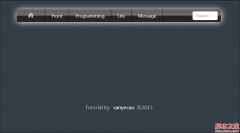动态加载外部css或js文件
原理解析:第一步:使用dom创建<script>或者<link>标签,并给他们附加属性,如type等第二步:使用appendChild方法把标签绑定到另一个标签,一般是绑到<head>.
应用:1、提高代码的复用,减少代码量;2、添加一个javascript控制器和 session可以实现动态改变页面样式;3、由于是页面是从上到下依次加载文件的,并且边加载边解释,所以可以添加javascript控制器控制页面文件的加载顺序,如先加载css布局文件,再显示有图片的css美化文件,之后再加载大的falsh文件,或者安内容的重要性来加载。r
阅读提示:e文不好的初学者可以直接看中文,然后拷贝代码试验下。r
To load a .js or .css file dynamically, in a nutshell, it means using DOM methods to first create a swanky new "script" or "LINK" element, assign it the appropriate attributes, and finally, use element.appendChild() to add the element to the desired location within the document tree. It sounds a lot more fancy than it really is. Lets see how it all comes together:
function loadjscssfile(filename, filetype){
if (filetype=="js"){ //判定文件类型
var fileref=document.createElement('script')//创建标签
fileref.setAttribute("type","text/javascript")//定义属性type的值为text/javascript
fileref.setAttribute("src", filename)//文件的地址
}
else if (filetype=="css"){ //判定文件类型
var fileref=document.createElement("link")
fileref.setAttribute("rel", "stylesheet")
fileref.setAttribute("type", "text/css")
fileref.setAttribute("href", filename)
}
if (typeof fileref!="undefined")
document.getElementsByTagName("head")[0].appendChild(fileref)
}
loadjscssfile("myscript.js", "js") //打开页面时浏览器动态的加载文件
loadjscssfile("javascript.php", "js") // 打开页面时浏览器动态的加载"javascript.php" ,
loadjscssfile("mystyle.css", "css") //打开页面时浏览器动态的加载.css 文件
接下来的工作是绑定到<head>标签。绑定的时候有一个问题就是同一个文件有可能被我们绑定两次,绑定两次浏览器也不会出现异常,但是效率就低了。为了避免r
这种情况我们可以新增一个全局数组变量,把绑定的文件名字保存在里面,每次绑定前先检查一下是否已经存在,假如存在就提示已经存在,假如不存在就绑定。r
document.getElementsByTagName("head")[0].appendChild(fileref)
By referencing the HEAD element of the page first and then calling appendChild(), this means the newly created element is added to the very end of the HEAD tag. Furthermore, you should be aware that no existing element is harmed in the adding of the new element- that is to say, if you call loadjscssfile("myscript.js", "js") twice, you now end up with two new "script" elements both pointing to the same Javascript file. This is problematic only from an efficiency standpoint, as you'll be adding redundant elements to the page and using unnecessary browser memory in the process. A simple way to prevent the same file from being added more than once is to keep track of the files added by loadjscssfile(), and only load a file if it's new:
By referencing the HEAD element of the page first and then calling appendChild(), this means the newly created element is added to the very end of the HEAD tag. Furthermore, you should be aware that no existing element is harmed in the adding of the new element- that is to say, if you call loadjscssfile("myscript.js", "js") twice, you now end up with two new "script" elements both pointing to the same Javascript file. This is problematic only from an efficiency standpoint, as you'll be adding redundant elements to the page and using unnecessary browser memory in the process. A simple way to prevent the same file from being added more than once is to keep track of the files added by loadjscssfile(), and only load a file if it's new:
Here I'm just crudely detecting to see if a file that's set to be added already exists within a list of added files' names stored in variable filesadded before deciding whether to proceed or not.
Ok, moving on, sometimes the situation may require that you actually remove or replace an added .js or .css file. Lets see how that's done next.
本文网址:https://www.dedexuexi.com/divcss/jc/1755.html
本站部分文章搜集与网络,如有侵权请联系本站,转载请说明出处。












